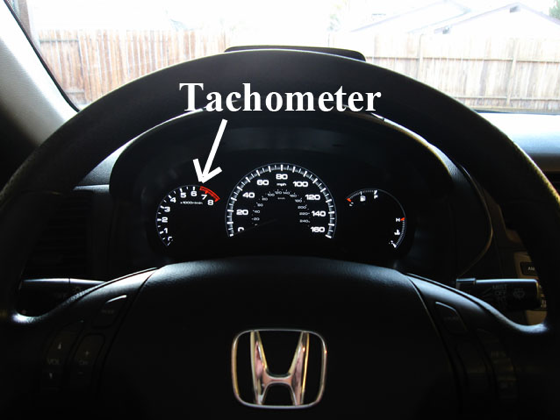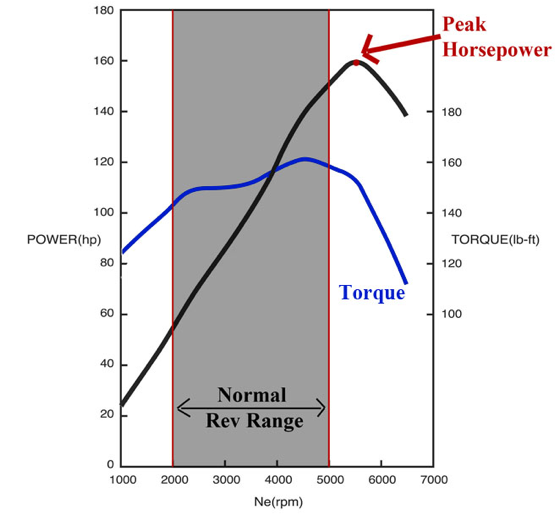Horsepower and Torque

The automakers have done a great job making much ado about nothing. Nearly everybody has heard of the term “horsepower,” and yet, shockingly few people know what it actually means or what it measures. This article attempts to rectify that by putting into perspective how horsepower means almost nothing to the average driver.
Basic Terms
Engine RPM, or Revolutions Per Minute. This is a measure of how fast the engine is spinning/revolving (“revving”) and how hard its working. Most people generally keep their RPM’s between 2000 and 5000RPM, depending on engine and driving style.
The engine RPM is reported by the tachometer, which most (but not all) cars have on the instrument panel (see picture). The tachometer often shows single or double digit numbers, which are multiplied by 100 for double digit numbers or 1000 for single digit numbers, in order to display actual engine speed.
The beginning of the red section is called the engine redline, and going beyond the redline can result in thousands of dollars in engine repairs. Not all tachometers have a redline.
What is Torque?
Torque is defined as the tendency of a force to rotate an object. The torque produced from an engine eventually reaches the wheels, which translates that rotational force into acceleration. In simpler terms, torque is what accelerates your car. Increasing the amount of torque produced would make the car accelerate faster, which is felt as the “shoved into the seat” sensation.
What is Horsepower?
Horsepower is simply a number calculated from torque and RPM. That’s right – horsepower is not directly measured, but instead calculated from the following formula:
Analyzing this formula will tell us an important fact. If we assume that torque is the same at 2000RPM as it is at 5000RPM, then the formula says there is more horsepower at 5000RPM (this is true). Despite having more horsepower at higher revs, you won’t feel a bigger shove into the seat at higher revs if torque (your motive force) stays the same.
Why do I care?
Automakers are always touting that their vehicles make so much horsepower, and consumers don’t realize that this horsepower number is largely irrelevant. First, as we’ve established, torque is what moves the car, and horsepower is simply a calculated number. Second, most manufacturers tune their engines to produce good torque between 2000 and 5000RPM. This is the rev range that the general public uses in everyday driving. Thus, torque is fairly constant between 2000 and 5000RPM for most engines, making RPM the biggest factor in the horsepower formula. As a result, the horsepower quoted by manufacturers is at an astronomically high RPM that most consumers will never reach in normal driving. This is shown below by a graph. This graph represents the horsepower and torque produced by a 4 cylinder engine from a 2003 Honda Accord. Horsepower almost universally rises until it peaks at 5500RPM, but torque does not rise dramatically. More importantly, the peak horsepower (160HP @ 5500RPM) is clearly out of the normal rev range that most drivers use. Thus, the engine’s peak horsepower is irrelevant since the typical driver will never achieve it.
So why do we bother with measuring horsepower?
Great question! It’s actually really simple – horsepower defines your top speed or potential acceleration rate for any given situation. Going back to the horsepower equation, you can create the same amount of horsepower by using high torque and low RPM, or by using low torque and high RPM. You can use either method, and as long as you produce the same horsepower by the equation, you can produce the same acceleration by using the right gears.
So horsepower matters on a racetrack where drivers will use the entire rev range to their benefit. Horsepower also counts if you’re hauling a heavy load. If two trucks with the same gearing are hauling the same load, and are making identical horsepower, they will go up the hill at the same speed. It doesn’t matter if one is diesel and one is a high-revving race motor – as long as both are making peak HP in that situation, they go the same speed. In these cases, it doesn’t matter how much torque you have or how much RPM you have to use. The first area of concern is to git ’er done, and horsepower will determine whether that’s possible.
Horsepower sounds important to me, why do you say it isn’t?
Most drivers use only a very narrow part of the rev range, as mentioned. They feel that high RPM running stresses the engine and increases wear and tear (true, to some extent). High RPM’s also generates a lot more uncomfortable noise and vibration. Although horsepower can be produced by using high RPM, most drivers will never venture into the upper rev range for good reason. Thus, low RPM torque is much more important to the everyday driver.
A comparison between an Infiniti G37 sedan and a BMW 335i sedan illustrates this point. Both compete in the same realm – small, entry level sports luxury sedans. The G37 produces 328HP while the 335i produces “only” 300HP. Just looking at these figures, the general public would assume that the G37 is a faster car. That’s true – if you want to drive around at 7000RPM everyday, which is where the G37 produces its peak horsepower.
The G37 generates less torque but at a much higher RPM to produce more peak horsepower. As a result, it produces a maximum torque of 269lb-ft at a staggering 5200RPM – a higher RPM than most people would drive normally. The 335i engine uses turbocharging to produce 300lb-ft of torque at just 1400RPM. In fact, the 335i produces more torque than the G37 all the way up to over 6000RPM.
Since the G37 has more horsepower overall, it will win on a racetrack, assuming both cars weigh the same. The staggering torque numbers of the 335i ensure that in normal everyday driving, it can keep up with the G37 while never getting into the upper stratosphere of its rev range. This is especially prominent on highway passing tests. The goal is to get from 30 to 70MPH, in top gear, without downshifting. This is a test of usable low RPM torque and pulling power without having to downshift and rev up the engine. The Infiniti G37 takes 18.8 seconds to do this acceleration test, while the 335i does it in a mere 14.2 seconds. Even though the G37 has more horsepower, it accelerates 30% slower than the 335i in the rev range that people use every day. The buyers tricked into believing horsepower figures are staring at the rapidly-vanishing torque monster.



